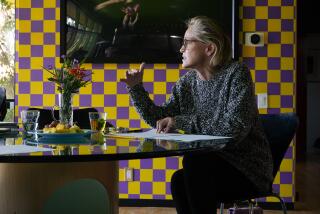One for the Books : KCET Uses Stars to Promote ‘Storytime’
- Share via
What’s so special about watching someone read picture books to a group of children?
Plenty, according to the folks behind “Storytime,” a series now in production at KCET-TV Channel 28 for an October premiere.
The premise is simple: On a bright, blue-and-pink, book-filled set, 4- to 7-year-olds gather to hear stories read by celebrities, among them John Ritter, Wilford Brimley, Paul Rodriguez and Rosalind Chao, and by “reading buddies”--people such as librarians who are accustomed to telling tales.
There is also a personable host (actress Marabina Jaimes) and a wise-cracking, sneaker-wearing puppet named Kino, who resembles an 8-year-old boy; the two interact with the children and each other between stories.
The intent, however, is one of far-reaching proportions: to create an early passion for books that can transform a child of the television age into a lifelong reader.
“We want to create a strong impression that books are fun, that one can get as much enjoyment out of reading as watching television or playing video games,” says Julio Moline, “Storytime” senior producer and writer. “We’re using the power of television to present reading to kids in a positive light.”
The program is not aimed only at children, though, says Stephen Kulczycki, KCET’s senior vice president and station manager, who has been closely involved in the show’s development since it was first suggested 18 months ago by writer Douglas Bailey.
“We think that the idea of having people who are good at reading will give those who do read to kids--parents, aunts, uncles, older sisters and brothers, grandparents--a little extra nudge, to show how much fun it is to spend time doing this and how much opportunity there is for connecting with kids,” he says.
“There’s a kind of magic that happens,” Kulczycki says. “The reading, only slightly supplemented by illustrations and a tiny bit of music and sound effects, creates an experience on television that is enticing. One of the lessons of (PBS’) ‘The Civil War’ project was that what made it so strong was the words and the way they were rendered. The images were secondary.”
To that end, Kulczycki believes that “Storytime” is unique among series that have presented storytelling, in that it places as much emphasis on the people reading the books as on the books themselves. Rather than filling the television screen with close-ups of the books’ illustrations, the program shows the relationship between storyteller and listeners.
At one recent taping, for instance, Mayim Bialik of NBC’s “Blossom” read “The Cat Who Lost His Purr” by Michele Coxen. When called for, she provided the sounds of a washing machine, dripping water and a buzzing fly, and afterward she solicited suggestions from the children in the studio audience about what attributes other animals might lose.
On another episode taped later that day, Fred Savage of ABC’s “The Wonder Years” read “Willy the Wimp” by Anthony Browne, then talked with the kids about the story’s meaning. He listened with the others while reading buddy Leah Komaiko read her own tale, “Earl’s Too Cool for Me,” which was supplemented by neon-framed sunglasses for the audience--including puppet Kino--to epitomize “cool.”
Savage, whose own mother read to him as a youngster, was enthusiastic about his part.
“When people read to you at an early age, it sets a foundation for almost everything--speaking, reading, writing essays in school,” he says. “Reading, to me, unlocks doors you couldn’t get into, allows you to go places and meet people you wouldn’t otherwise. I’m really honored that they gave me the opportunity to do this.”
In choosing the books--60 to 70 in all, as each of the series’ 20 episodes presents two to four stories--the “Storytime” team enlisted the aid of more than 100 people, including an advisory board of child psychologists, librarians, teachers, bookstore owners and others. They looked for stories covering a wide ethnic and cultural range, with rhythmic language in which children could get caught up, and characters to whom they could relate.
Celebrities were matched with appropriate selections: Teen-ager Bialik also read a version of “Goldilocks and the Three Bears” because of the young girl who is the story’s heroine, while Michael Dorn of the syndicated “Star Trek: The Next Generation” read “Company’s Coming” by Arthur Yorinks, about a spaceship landing at a suburban house. African-American actress Alaina Reed Hall read the African-themed “Not So Fast, Songololo” by Niki Daly.
Some scenes are being taped at locations such as parks and private homes. “We’d like very much to create situations that are realistic,” explains Moline, “like parents reading to their young son as he goes to bed. We want to capture the intimacy, show what a wonderful moment that can be.”
More to Read
Sign up for our Book Club newsletter
Get the latest news, events and more from the Los Angeles Times Book Club, and help us get L.A. reading and talking.
You may occasionally receive promotional content from the Los Angeles Times.








